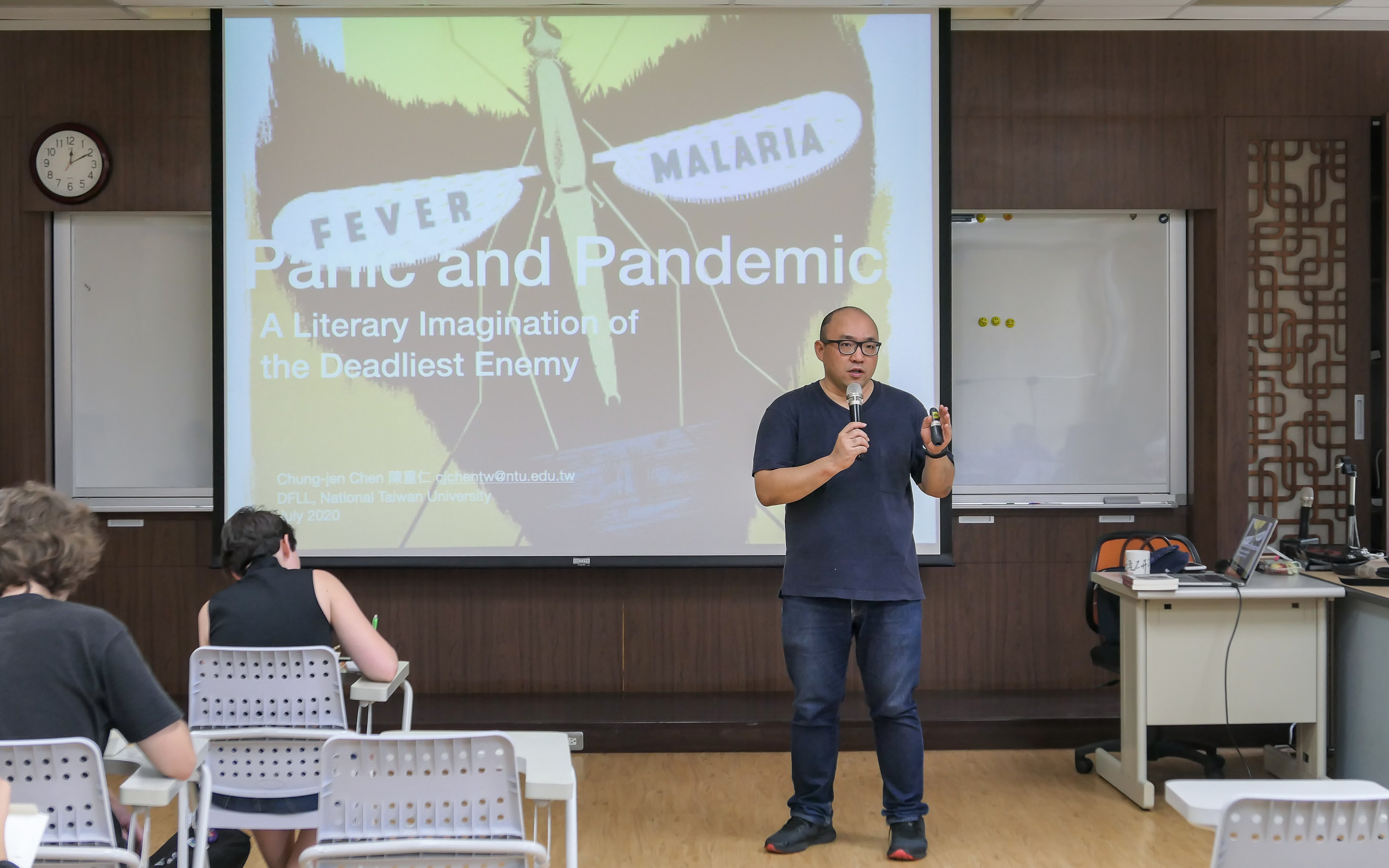
【English Below】
處於危急之中,人類總希望以最簡單的敘述來尋找亂中之序。處於疫情之中,則善用「比喻」給無形以形狀、給未知以實像。
即使將此現象視為理所當然,臺大外國語文學系教授陳重仁的研究既不受時間限制,又有先見之明。通過文學調研,他發現一個古今中外皆一再重複的隱喻,亦即「以疾病為敵」。ICLP於7月10日榮幸歡迎陳老師來講述該研究,並討論當前與疫情有關的比喻意象。
二十世紀初的抗瘧宣傳海報體現了陳老師所造的「概念隱喻公式」:提起一個現象時,自然使人聯想到一連串的相關意象,這些概念就像疾病一樣有傳染性。
「一旦看到構成威脅的事物,自然而然就會把它視為敵人。一旦把它視為敵人,就會聯想到與『敵人』有關的各種事物」陳老師解釋。
對二十世紀初的西方國家來說,德國和日本就是最具體的「敵人」,因此,防瘧宣傳經常將蚊子與德國或日本士兵並列放置,描繪盟軍用槍枝或噴壺攻擊敵軍的畫面。
臺灣人對另一種政治諷喻很熟悉,當時有個常用來美化蔣介石的軼事。在衛生課上,蔣介石的日本教官拿出一塊泥土說:「這塊泥巴裡可以容納四萬萬個微生物,就好比你們中國有四萬萬人寄生在這裡面。」蔣介石一聽就從那塊泥土上掰下一塊,反問:「日本有五千萬人口,是否也像您所說的那樣,是五千萬微生物寄生在這泥巴裡呢?」微生物寄生帶來疾病和或禍患,正如討厭的事情形影相隨,對日本教官來說意味著中國人寄生在土地上,但對蔣介石來說寄生的微生物反而意味著日本。
放眼當前形勢,也出現類似的比喻模式。
「不管是瘧疾、霍亂、黃熱病、新冠肺炎等疾病,所有的隱喻都一模一樣:雖然會帶你到不同的結論,但都代表其他恐懼的對象,」陳老師稱:「但是現在我們沒有什麼明顯具體的敵人,所以就得編造出敵人。」
由於缺乏敵人,各方推卸責任,諉過於人:川普指責中國,甚至將新冠肺炎稱作「中國病毒」,中國同時也指責他國,說病毒起源於歐洲或美國的軍事基地。
不過,言論尚未落到第二次世界大戰的境界,尚未按照同樣簡單的公式,像「疾病等於敵人等於德國和日本」。當前的疫情言論反而具有一種「強烈的民族主義色彩」,同時也呼籲公民都接受並承擔個人責任。
「我們目前沒有敵人,但是必須對所有人負責,」陳老師說道:「你就屬於所謂的『所有人』,是我國的公民,應該對國家負責,對自己負責。」
在臺灣,民族主義情緒尤其強烈。政府推動「Taiwan Can Help」宣傳策略,並稱讚參與防疫措施的人員是「臺灣國家隊」成員,同時竭力譴責中國。
在中國,民族主義言論以人民的犧牲為主,讚揚武漢人民為封城抗疫而備受艱辛,正如抗日戰爭期間被敵軍屠殺上萬人的南京——殘酷的敵人再一次成為疾病的象徵物。
無論時代背景如何,對疾病的描述富有隱喻性,也具有反映出人類本質的獨特力量。儘管全球化帶來了空前的繁榮,但是新冠肺炎迫使全世界面對長期存在的社會不公。據陳老師所說:「我們曾經以為成功地創造了不屬於任何一種過去的時代,但是依然重複著恐懼的固定套路,活在傳染病的陰影下。」
鑒於疾病的隱喻所蘊含的力量,探索對疫情的各種反應之後,我們不僅可以了解我們心中的敵人和恐懼,更可以知道我們的願望和抱負。
「疾病顯示了社會的事實以及內心的恐懼,是以共同敵人的形象而形成的。同時,疾病也帶來期望,是對於美好未來的期望。」陳老師稱。
In times of crisis, people reach for simple narratives to feel agency amid chaos. In the case of contagion, metaphors are tools that can give shape to a faceless enemy and urgency to an unknown threat.
In this regard, C.J. Chen’s research is both timeless and prescient. Through his survey of disease in literature, the professor of foreign languages and literatures at National Taiwan University has discovered a recurrence of the metaphor of disease as enemy stretching across Western and Asian writings. ICLP on July 10 had the honor of hearing Chen’s insights and discussing their relevance to the COVID-19 pandemic.
Anti-malaria propaganda posters from the early 20th century typify what Chen calls the “formula of metaphor”: One association will naturally lead to another and another, in this way spreading like disease itself.
“Once we see something that we regard to pose a threat to us, it would be a natural instinct to visualize them as enemies. Once we start to see them as enemies, we add up all kinds of things that can be associated with the enemy,” Chen said.
To Western nations of the time, “the enemy” was naturally equated with Germany and Japan. Accordingly, propaganda posters often juxtaposed mosquitos with German and Japanese soldiers, cowering from Allied soldiers’ guns/spray bottles.
Taiwanese are familiar with another type of political allegory, which like many at the time served to glorify Chiang Kai-shek. During a lesson on hygiene, his teacher in Japan placed a small clump of dirt on his desk to illustrate that it has 400 million microbes, the same as China’s population. In response, Chiang suggested that a clump with 50 million microbes — Japan’s population — would be one-fifth the size. Here the germ is metaphorically extended to encompass other things considered to be dirty or inimical, which to the Japanese teacher implies China, and to Chiang implies Japan.
In our current pandemic, similar patterns emerge.
“All the metaphors of illness — malaria, cholera, yellow fever, COVID-19 — mostly are all the same: They lead you to something else, something you fear,” Chen said. “But now we don’t have such conspicuous enemies, so we make up enemies.”
This is how a cornucopia of blame has emerged, with Donald Trump calling COVID-19 the “China virus” and China attempting to implicate the US military and Europe.
However, the rhetoric always stops short of the explicit World War II formula “disease equals enemy equals Germany and Japan.” Instead, language around the pandemic has taken on a “very strong hue of nationalism,” along with calls for personal responsibility.
“We don’t have an enemy now, but we have responsibility for everyone,” Chen said. “You are that everyone, you are a citizen — you should be responsible for your country and for yourself.”
Nationalist sentiment has become particularly strong in Taiwan, where the government has been promoting the “Taiwan can help” slogan and praising those involved in virus prevention measures as members of the “national team” (臺灣國家隊), while also taking pains to lay blame at China’s feet.
In China, nationalist rhetoric has centered the people’s sacrifices. Wuhan is held up alongside other cities famous for the hardships they have endured on behalf of the nation, particularly Nanjing during the Second Sino-Japanese War.
No matter the era or context, disease is a powerful metaphorical mirror for ourselves. COVID-19 is now forcing the world to face its longstanding inequities, despite the unprecedented prosperity globalization has created. In Chen’s words: “We thought we had created a time that belongs to nowhere, but we still have to go back to the routine of fear under the shadow of contagion.”
However, we might use our collective response to evaluate not only our enemies and fears, but also our hopes and aspirations.
“Disease tells us about the society we live in. Disease tells the fear we have in our mind in the projection of the overall common enemy. [But also], disease tells us what we anticipate,” Chen said. “It tells us about anticipation for a better future.”

© ICLP-NTU. ALL RIGHTS RESERVED.